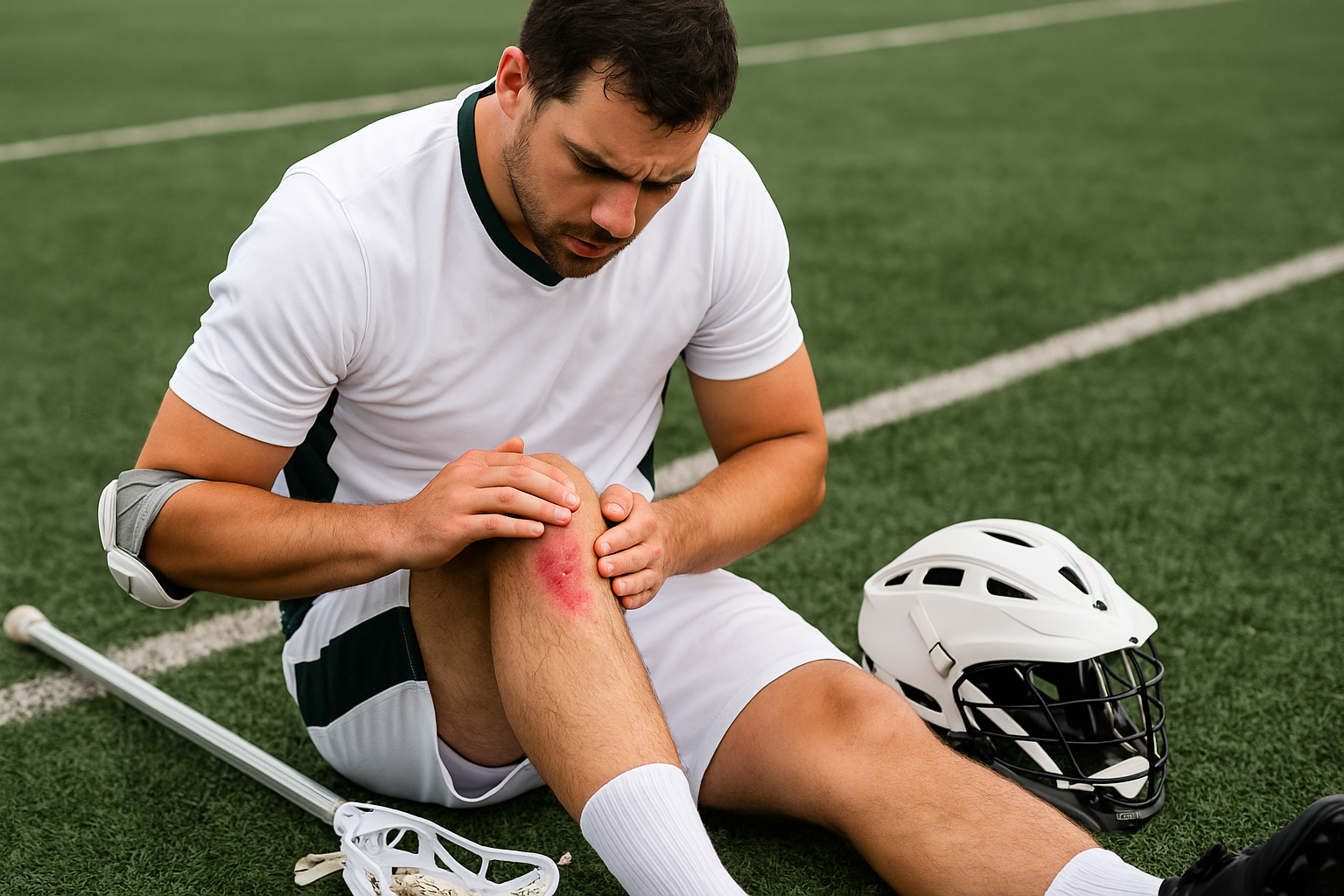

How to Treat Turf Burn in Lacrosse (and Other Sports)
You know that feeling when you slide for a ground ball and suddenly your knee is on fire? Or when you dive for a save and come up with your elbow looking like hamburger? Yeah, that's turf burn.
If you play lacrosse, football, soccer, or field hockey, you've probably dealt with this before. Artificial turf is basically sandpaper disguised as a playing surface. One wrong slide and you're walking around with raw, stinging skin that makes you wince every time you move.
The thing is, most turf burns aren't that serious if you take care of them right. Sure, they hurt and look nasty, but with some basic first aid, you'll be back to normal pretty quickly. Ignore them though, and you might be dealing with an infection that keeps you off the field way longer than necessary.
So let's talk about what turf burn actually is, how to clean it up properly, and, probably most importantly, how to avoid getting torn up in the first place.
What is Turf Burn?
Turf burn is a friction burn that happens when skin scrapes against artificial turf. Pretty straightforward. The synthetic fibers don't bend like real grass does. Instead, they grip and drag, shaving off the top layer of skin. Doctors call it a "sports abrasion," but players just call it painful.
The American Academy of Dermatology uses a special term: partial-thickness skin loss. What that really means is the burn goes deep enough to expose nerve endings. That's why it stings way more than you'd expect from what looks like a simple scrape.
Symptoms You'll Recognize
If you've had turf burn before, you know the signs immediately:
-
Sharp, intense sting right when it happens
-
Raw, red skin that looks like it's been peeled back
-
Sometimes bleeding, sometimes just clear fluid seeping out
-
That burning sensation that doesn't quit - it can linger for hours
Most Common Ways It Happens
Any time you slide, dive, or crash onto synthetic turf, you're at risk. The heat and friction build up fast, your skin can't protect itself, and the outer layer just gives way. You're talking about just a few seconds of contact being enough to do real damage.
Why Artificial Turf Makes Everything Worse
Artificial turf is just brutal compared to natural grass. Real grass gives a little when you hit it. Turf doesn't budge. Those plastic fibers stay rough, and they get even rougher when it's hot outside. The whole surface basically becomes sandpaper waiting for exposed skin.
You see this most in lacrosse, football, soccer, and field hockey. Goalies diving for saves, defenders sliding into plays, tackles that don't go quite right. Anyone who's played these sports long enough knows exactly what this feels like.
The usual targets? Your knees take the worst of it. Elbows get torn up when you try to catch yourself. Forearms when you hit the ground wrong. Hips when you take a really hard hit. That's why abrasions happen more often on turf fields, and why they feel so much nastier than the same injury on natural grass.
Cleaning and Infection Prevention
Proper wound cleaning starts immediately after injury and significantly reduces complications. Research shows that thorough wound irrigation reduces bacterial contamination by 70 percent, making this step crucial for preventing infected turf burn.
Start with clean hands. Wash thoroughly before touching the wound. This prevents introducing bacteria into the open area.
Follow these essential steps to clean your turf burn properly:
-
Use mild soap and lukewarm water
-
Clean gently - no aggressive scrubbing
-
Remove artificial turf particles carefully
-
Pat dry witha clean towel (don't rub)
Never use hydrogen peroxide or alcohol on open wounds. These harsh chemicals damage healing tissue and can actually slow recovery. Gentle cleaning with soap and water proves most effective for artificial turf injuries.
Medical studies indicate that artificial turf injuries have higher infection rates than natural grass injuries. Synthetic materials harbor bacteria and create additional contamination risks, making vigilant monitoring essential.
Warning Signs You Shouldn't Ignore
Keep a close eye on your healing wound and watch for these red flags that signal infection:
-
Redness that's spreading out from the original injury
-
Yellow fluid or thick pus coming from the turf burn
-
The area getting more swollen and feeling hot to the touch
-
Red streaks extending away from the wound
Catching infection symptoms early means you can get treatment fast and avoid serious problems down the road. Don't play the waiting game if you start noticing these changes.
You need to contact a medical professional right away if any of these serious situations develop:
-
Any of the infection warning signs show up
-
The wound is bigger than your palm
-
You've got a deep abrasion that won't stop bleeding heavily
-
You can see underlying tissue through the injury
Treatment and Healing Tips
Once the scrape’s cleaned, you’ve really got two jobs: keep the germs out and give the skin a chance to grow back. Simple in theory, harder in practice. Most people go straight for ointment, and honestly that’s the right move. A thin layer of antibiotic cream, Neosporin, Bacitracin, whatever’s in the kit, covers the wound and keeps bacteria away. Petroleum jelly? It’ll keep things damp, sure, but it doesn’t fight infection. That’s the big difference.
We’ve seen players swear by letting wounds “air out.” Doesn’t work as well. The science shows it too: moist wounds heal faster than dry ones. Even if it feels counter-intuitive, a little barrier on top really speeds things along.
Location-Specific Care
Now, where the burn lands makes recovery a different game. Joints are the worst. Movement pulls at the skin and at the bandages too.
Take the knee. Every step bends it, every slide risks tearing it open again. You’ll need padding, flexible wraps, and the patience to re-cover it when it slips.
The elbow? Just as frustrating. You wrap it, it slides down. Make it too tight, circulation suffers. Most athletes end up changing elbow bandages twice in a day, especially if they’re practicing.
Both spots feel like a battle. You think it’s secured and five minutes later the bandage is loose. Still, keeping them covered is better than dealing with dirt and sweat grinding straight into the wound.
Best Ointments and Dressings
Antibiotic ointment is the baseline. Everyone uses it. For deeper scrapes, hydrogel sheets work better; they hold steady moisture. Hydrocolloid patches give cushion and create the kind of environment skin likes for regrowth. They cost more, but when a player’s mid-season, they’re worth it.
Should every turf burn be wrapped? Not really. In games or training, yes, cover it. At home, small ones often heal faster if they get some air.
The usual toolkit looks like this:
-
Non-stick pads for everyday use
-
Hydrogel sheets for the nastier burns
-
Hydrocolloid patches when cushioning is needed
-
Breathable tape to hold everything in place without strangling the skin
How Long Turf Burns Take to Heal
Most heal within a week or two. Some drag on if they’re deep or on a joint. Knees and elbows nearly always take longer. Younger players bounce back faster, but not every time.
Things that matter most:
-
how deep the skin was scraped
-
whether it’s kept clean
-
if activity keeps reopening it
-
the spot (joints slow everything)
-
overall health and age
Fastest recovery? Same answer every trainer gives. Keep it clean. Keep it moist. Keep it covered when you play. And do your best not to reopen it. Sounds boring, but it works.
Preventing Artificial Turf Injuries
We've learned that preventing these injuries beats trying to heal them after the fact. When we use the right protective gear consistently, we can cut down on friction burns dramatically. It's one of those situations where spending a bit upfront saves us a lot of pain later.
What We Need to Protect Ourselves:
-
Long sleeves and compression leggings (they're lifesavers)
-
Knee pads - absolutely essential if we want to avoid those nasty knee burns
-
Elbow guards to keep our arms intact
-
Compression sleeves worn under our regular equipment
Turf Burn in Lacrosse: Why It's So Common
Anyone who's played lacrosse knows how brutal turf burns can be. The sport just naturally puts you in situations where you're hitting the deck constantly - and artificial turf doesn't forgive.
What Happens in a Typical Game
Think about what happens in a typical game. Goalies are throwing themselves at shots without thinking twice. Defenders are sliding all over the place trying to break up plays. Face-offs turn into these chaotic scrums where everyone ends up on the ground. And don't get me started on chasing down ground balls - you're basically guaranteed to eat turf at some point.
Why Lacrosse Creates the Perfect Storm
The thing is, lacrosse creates this perfect storm for getting torn up. You've got players moving at full speed, lots of body contact that sends people sliding, and most facilities these days use artificial turf (which honestly feels like sandpaper when you hit it wrong). Plus, lacrosse gear leaves plenty of skin exposed compared to other sports.
Where Players Get Hit the Worst
We've seen players get it worst on their knees from defensive slides, elbows from scrambling for loose balls, and forearms from all the stick contact. Hip burns are pretty common too when you take a hard hit.
Prevention That Actually Works
But here's the good news - you can actually do something about it. We've noticed that players wearing compression gear under their uniforms get way less beat up. It's not just me saying this either; there's real research showing protective layers make a huge difference.
Your team should always have a well-stocked first aid kit ready to go. Get some quality athletic tape specifically designed for turf sports. Invest in compression sleeves and underlayers - trust me, they're worth every penny. And coaches need to spend time teaching players how to fall and slide properly. Good technique can save your skin, literally.
The Bottom Line
Look, you're going to get scraped up playing lacrosse - it's part of the game. But there's no reason to suffer more than you have to. Take care of wounds right away (clean them out, use some antibiotic cream, keep them from drying out), and gear up properly before you hit the field.
The players who stay healthiest are the ones who plan ahead. Good protective equipment combined with smart wound care will keep you in the game longer and feeling better while you're there.
